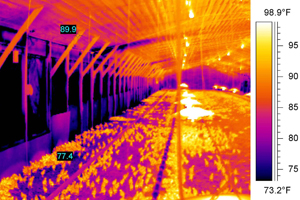Estimating air leakage in the poultry house

In order to control the environment within a poultry house, it is essential that a producer not only controls how much air is entering the house, but where it is entering.
For instance, during cold weather essentially no air should enter a house when the fans are off. When the fans are operating, all the air should enter through the air inlets so it can be directed along the ceiling toward the center of the house to insure it is preconditioned by the warm air next to the ceiling before moving down to bird level.
Air entering through cracks or gaps in side wall curtains whether the fans are on or off can lead to drafts, caked litter, and excessive fuel usage.
During the summer, in order to maximise bird cooling all incoming air should enter through a house’s evaporative cooling pads. Air entering through cracks leads to hotter side walls, increased temperature differentials between the pads and fans, and poor air speed distribution, all of which can reduce weight gains and increase feed conversions.
To minimise the problems associated with air leakage it is essential that poultry producers are aware of how tight their houses are so that corrections can be made before bird performance suffers and/or heating costs become excessive.
More and practical advice on this matter is available from the University of Georgia, Athens, GA USA.
Join 31,000+ subscribers
Subscribe to our newsletter to stay updated about all the need-to-know content in the poultry sector, three times a week. Beheer
Beheer








 WP Admin
WP Admin  Bewerk bericht
Bewerk bericht